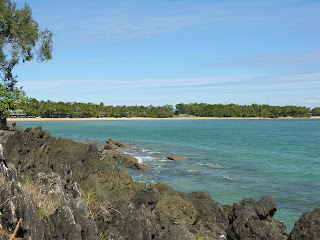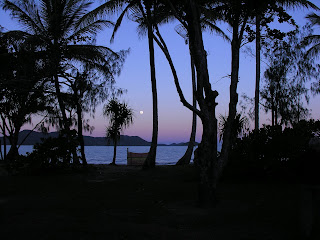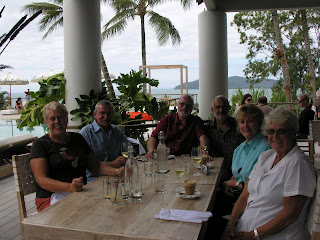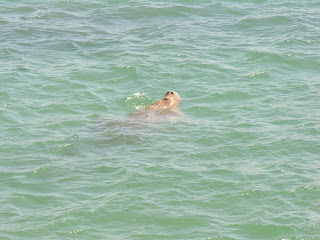



Mission Beach to Townsville
South Mission Beach was named after a Mission set up in 1914. The first white settlers came to the area in the 1880’s and set up a farm in Bingil Bay nearby to grow bananas, mangoes, coffee, citrus fruit and coconuts. Early in the 20th century Chinese banana farmers used aboriginal labour, but opium addiction and conflict with European settlers was resolved by the Queensland Government setting up a Mission to house the remaining indigenous people in the area. A monument and interpretive display tells of many sad stories of the people there. Many tried to escape back to the farms and were brought back shackled together. In 1918 a huge cyclone which brought tidal waves and strong winds devastated the area and some 200 lives were lost. After that the remaining people were taken over to a settlement on Palm Island. Now of course it is a very popular tourist destination.
South Mission Beach was named after a Mission set up in 1914. The first white settlers came to the area in the 1880’s and set up a farm in Bingil Bay nearby to grow bananas, mangoes, coffee, citrus fruit and coconuts. Early in the 20th century Chinese banana farmers used aboriginal labour, but opium addiction and conflict with European settlers was resolved by the Queensland Government setting up a Mission to house the remaining indigenous people in the area. A monument and interpretive display tells of many sad stories of the people there. Many tried to escape back to the farms and were brought back shackled together. In 1918 a huge cyclone which brought tidal waves and strong winds devastated the area and some 200 lives were lost. After that the remaining people were taken over to a settlement on Palm Island. Now of course it is a very popular tourist destination.




We settled into our beach front cabin quickly with it’s $1 million dollar view across to Dunk and Bedarra Islands, and mountains very close by. We had booked for 4 nights but quickly extended it to 8, as did our friends. Again, there were many opportunities for walking, either on the beach or in tracks. Rain forests actually come right down to the beach. The water was relatively warm but not that great for swimming. The weather was a bit cloudy at times and the winds came up in the afternoon. Boats, both for sailing and fishing, were available for hire on the beach and also it is a popular paragliding spot. We noticed a lot of coconuts on the ground but also many trees have baskets under the coconuts, thus preventing accidents.





We had a very pleasant lunch one day at a luxury resort on the top of the hill which overlooked the water, and it is a very popular place for weddings. They were setting up for one that afternoon. Another afternoon we drove over to Mission Beach itself and had a walk up the main street, with the usual beach clothing, beach furniture, coffee shops and restaurants. You have to be very watchful while driving on the roads around Mission Beach as it is a cassowary sanctuary and there are a lot of kangaroos around at night and early morning..




When the winds dropped a little we decided to take a water taxi over to Dunk Island for the day. This meant boarding the taxi in knee deep water with the waves rolling in so that was a bit different. The skipper held the boat and told us when to jump on the step, so we didn’t get too wet. The trip over was a bit rough but it was only for about 10 mins and on Dunk Island it was protected and much easier to get off. We decided to take the walk through the rain forest area past the resort to Muggy Muggy Beach. There are many other walks on the island but time was limited. Just off the shore we observed a dugong (sea cow) swimming around and feeding off the sea grass. We were fortunate to get a photo as they don’t surface for very long. By the afternoon the winds had come up again so our trip back was a bit rougher than before. Again interesting getting off the boat but we managed to stay fairly dry. It would be great to spend a few days over on Dunk to savour the tropical island experience.




Our next trip was a visit to Paronella Park, a 45 minute drive from Mission Beach, at Mena Creek on the Canecutter Way inland from Innisfail. It is quite unique and was the dream of a Spaniard, Jose Paronella, who came to the area in the early 1900’s and wanted to build a castle. The castle is on 5 hectares of land beside the Mena Creek Falls and was opened to the public in 1935, complete with picnic area, a café, tennis courts, movie theatre, bridges, a tunnel and 7,500 tropical plants and trees. The castle is now in ruins. Of particular interest is a kauri grove, with most of the trees being planted in 1932. We arrived in time for a guided tour at 4.00 p.m. and stayed on for the tour by night when parts of the castle and gardens are floodlit and you get to feed the giant eels which come in each evening. To spawn they travel to the Samoan Islands and the young find their way back to the river and falls. The castle must have been a wonderful sight in it’s early days with it’s buildings, including a ballroom and a grand staircase. Jose also installed a hydro electricity station in 1933, positioning the turbine with block and tackle. The castle hosted many weddings and it was a popular spot for honeymooners. It was let go for many years after Jose fell ill and a large flood in 1946 destroyed many areas.






The present owners took over some 14 years ago and are dedicated to restoring the castle and surrounding areas where possible. The site now has State and National Heritage and National Trust listing. Part of the castle wall was knocked down by Cyclone Larry some two years ago, but the cyclone also opened up original views to the water fall from the café gardens. Now musical and theatrical events are held for charity, which I think would be a magical experience. The park has been used for a movie setting and another movie will be filmed next year. The turbine from the hydro electric plant is being restored and eventually the hydro station will be operating again. The present owners are as passionate about the project as Jose was originally and I’m sure it will be a great success.




Our stay in Mission Beach was very relaxing and the guys got to have a game of golf while the girls went into the town of Tully. On Wednesday 20th August, we made our way down to Rollingstone, one of the beaches north of Townsville stopping off in Cardwell and Halifax on the way. The caravan park was right on the beach, but had no cabins, so we pitched our tent on an “en suite site”, which meant we had our own bathroom next to our tent. We had another relaxing time there where golf and fishing were on the agenda. As there were still crocodile warnings for the area, you had to keep a very watchful eye while fishing in the creek. The golf course was home to kangaroos and whistling ducks and very pretty.




The girls took the opportunity to visit the Paluma National Park and drove for 26 km up a very winding and steep road to the crest at 2925 feet and one of the lookouts. Quite often the mountain is shrouded in clouds but we were able to look out to the coast, although it was very misty. Rainforest walks are also very popular. On the way back we stopped off to take photos of the historic bridge at Little Crystal Creek, built in 1932. The road was built in the Depression by the unemployment relief labour force.




There were also lots of birds, particularly black cockatoos in the park, and some kangaroos nearby. The camp kitchen was a popular spot for evening meals. Needless to say, sunsets were again brilliant. The only thing that spoilt our stay were the sand flies, and we all suffered from many bites, which took days to settle.























































